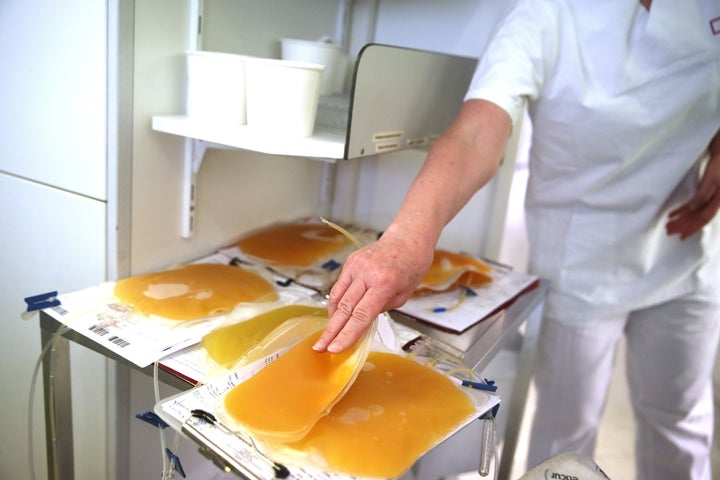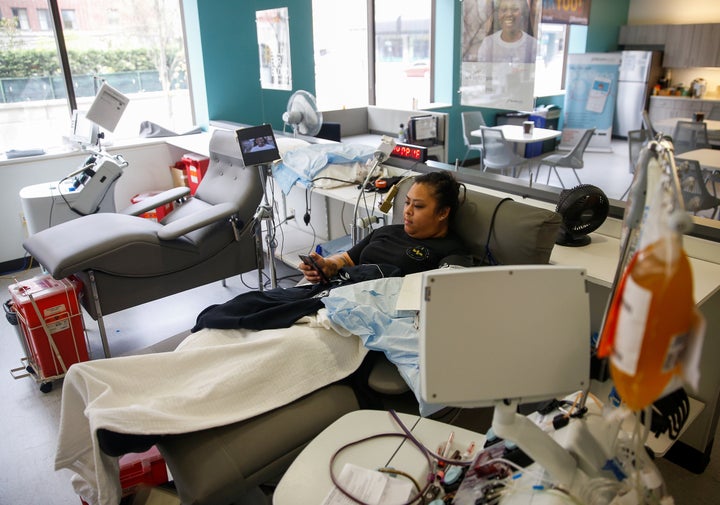[ad_1]
There’s no known treatment for COVID-19, but doctors and researchers are studying something they hope will do the trick: plasma from people who’ve recovered from the coronavirus.
Antibodies from the blood of people who have recovered from the illness are now being given to the sick to see if it helps their bodies fight the virus. Because there are many more people who are now battling the infection than those who have recovered, the blood plasma that contains these antibodies is in short supply, and donations are being encouraged.
Here’s what potential donors should know about the collection process, eligibility to donate, and how volunteering to give plasma can make a difference.
What is plasma?
Plasma is the fluid in your blood that carries red and white blood cells and platelets throughout your body. It makes up about 55% of your blood and is responsible for distributing nutrients, hormones and proteins. It also may serve as a waste receptacle for your cells. When separated from the rest of your blood, it is a pale yellow liquid.
Once a person contracts and recovers from a virus, his or her plasma may carry antibodies that can attack that virus. “Convalescent plasma,” as it’s known when donated for medical use, may help people battling the same virus by improving their chance of recovery or keeping them from getting sicker.
Why should you donate it?
Researchers are attempting to determine if plasma is an effective treatment for COVID-19. A very small study in China found that convalescent plasma appeared to help seven of the 10 patients who were tested. The Mayo Clinic, the prestigious Minnesota-based medical center, is currently running a study of its own evaluating whether plasma is helpful to patients infected with the coronavirus.

Because plasma transfusions are generally safe and there is no other known cure for COVID-19, the Food and Drug Administration said last month it supports doctors’ investigatory use of it.
Who can donate and when?
Most people who’ve been verifiably diagnosed with COVID-19 and have fully recovered from it are eligible to donate plasma to others battling the disease.
The Red Cross requires donors to be at least 17 years old, weigh at least 110 pounds and be in generally good health. The FDA requires people to be symptom-free for at least 14 days before donating.
Medical centers collecting plasma may screen donors first to see if their plasma has an adequate supply of antibodies.
Who can’t donate?
Men who have had sex with men in the previous three months, as well as women who have had sex with those men, cannot donate. In some instances, that time window may be 12 months.
That’s because of a decades-old FDA rule that once sought to prevent the spread of HIV by limiting donations from those groups, though experts in the field say those limits are no longer necessary. Though the FDA has shortened that window from 12 months to 3 months in light of the coronavirus, LGBTQ men seeking to donate plasma under the new parameters have reported being turned away because of the old 12-month guidance.

Blood centers widely support overturning the old FDA policy of singling out LGBTQ people, but say they haven’t had enough time to train staffers on new guidelines or update their computer systems to accommodate the revised rule.
The current FDA guidance also bans donations from people who’ve gotten tattoos or piercings in the previous three months.
Where should you go to donate?
People seeking to donate plasma for COVID-19 patients should check to see which of their local blood banks are participating in the collection.
The Red Cross is among the major organizations helping collect plasma. It will contact eligible donors who fill out its online form then direct them to a collection location, which may or may not be affiliated with the Red Cross.
The National COVID-19 Convalescent Plasma Project also has a database of national and local organizations people can register with to donate plasma.
The website DonatingPlasma.org also has a database where donors seeking to help COVID-19 patients can search for collection sites by zip code. However, because the push to collect such plasma is swiftly developing, the search tool may not show all collection sites.
What is the donation process like?
Donating plasma takes about one hour. A technician will draw blood from the donor’s arm. The blood is then spun in a centrifuge, separating the plasma from the other blood components, which are returned to the donor’s body.
Tom Hanks, who has recovered from COVID-19 since getting sick last month, shared some photos of what the process was like for him.
Collection centers recommend dressing warmly or bringing a blanket, since the facilities are kept cool. Donors will be able to read, listen or watch something throughout the process.
Most collection centers’ policies allow people to donate plasma every four weeks, a total of up to 13 times a year.
How high is the demand for plasma?
Excitement around the possibility of plasma being a COVID-19 cure has put donations in high demand. Some desperately searching for a treatment for loved ones have turned to social media.
Demand for convalescent plasma has outstripped supply by roughly two to one, The New York Times reported.
Part of the problem is that the U.S. still has a lot of sick COVID-19 patients and not as many recovered ones.
In Georgia, the state American Red Cross director said Wednesday they’ve only received a few donations.
“The demand has exceeded the supply because the sick people are running ahead of the people that are recovering,” director Dr. Baia Lasky told WRDW News.
Dr. Michael Joyner, the Mayo Clinic head researcher, said earlier this month he hopes to see the “trickle” of donations “grow into a river.”
A HuffPost Guide To Coronavirus
A HuffPost Guide To Coronavirus
Calling all HuffPost superfans!
Sign up for membership to become a founding member and help shape HuffPost’s next chapter



















